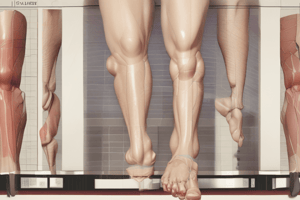Podcast
Questions and Answers
How many Osgood-Schlatter cases does the doctor treat in a year?
How many Osgood-Schlatter cases does the doctor treat in a year?
- 20 to 30 (correct)
- 10 to 15
- 50 to 60
- 100 or more
Patients with Osgood-Schlatter are typically referred directly to a sports medicine specialist.
Patients with Osgood-Schlatter are typically referred directly to a sports medicine specialist.
False (B)
What test can be used to check for provocative pain in the clinic?
What test can be used to check for provocative pain in the clinic?
Wilson test
Osgood-Schlatter typically affects the __________ region of the body.
Osgood-Schlatter typically affects the __________ region of the body.
Match the following terms with their descriptions:
Match the following terms with their descriptions:
What is the age range typically expected for Osgood-Schlatter's syndrome in females?
What is the age range typically expected for Osgood-Schlatter's syndrome in females?
Osgood-Schlatter's syndrome typically occurs only in males.
Osgood-Schlatter's syndrome typically occurs only in males.
What are some common symptoms experienced with Osgood-Schlatter's syndrome?
What are some common symptoms experienced with Osgood-Schlatter's syndrome?
Osgood-Schlatter's syndrome is often seen in adolescents aged _____ in males.
Osgood-Schlatter's syndrome is often seen in adolescents aged _____ in males.
Match the following symptoms with the correct description:
Match the following symptoms with the correct description:
What is the likelihood of healing when growth plates are still open compared to when they are closed?
What is the likelihood of healing when growth plates are still open compared to when they are closed?
Grade III lesions primarily occur in older adults.
Grade III lesions primarily occur in older adults.
What can happen to the bony maturation piece of bone if not addressed?
What can happen to the bony maturation piece of bone if not addressed?
The ossicle seen in the OCD lesion is a small piece of ______ that can become asymptomatic.
The ossicle seen in the OCD lesion is a small piece of ______ that can become asymptomatic.
Match the following conditions to their descriptions:
Match the following conditions to their descriptions:
Flashcards
What is Osgood-Schlatter disease?
What is Osgood-Schlatter disease?
Osgood-Schlatter disease is a condition that causes pain and swelling in the tibial tubercle, the bony bump just below the kneecap. It occurs during growth spurts in adolescents, typically between the ages of 12 and 15 for girls and 13 and 17 for boys.
What is the 'tug-of-war' in Osgood-Schlatter?
What is the 'tug-of-war' in Osgood-Schlatter?
The tug-of-war refers to the conflicting forces on the patellar tendon during growth spurts. The growth plate and the tendon are being pulled in opposite directions, leading to pain and inflammation.
What are the symptoms of Osgood-Schlatter disease?
What are the symptoms of Osgood-Schlatter disease?
Osgood-Schlatter disease typically presents as pain and tenderness over the tibial tubercle, often accompanied by swelling, redness, and warmth. The pain is typically worse with activities like jumping, kneeling, and running.
Who is most likely to develop Osgood-Schlatter disease?
Who is most likely to develop Osgood-Schlatter disease?
Signup and view all the flashcards
How is Osgood-Schlatter disease treated?
How is Osgood-Schlatter disease treated?
Signup and view all the flashcards
Why are Grade III OCD lesions easier to heal in young adolescents?
Why are Grade III OCD lesions easier to heal in young adolescents?
Signup and view all the flashcards
What happens to Grade III OCD lesions when the growth plates fuse?
What happens to Grade III OCD lesions when the growth plates fuse?
Signup and view all the flashcards
What can happen if a Grade III OCD lesion remains untreated?
What can happen if a Grade III OCD lesion remains untreated?
Signup and view all the flashcards
Where do Grade III OCD lesions commonly occur? What can make them worse?
Where do Grade III OCD lesions commonly occur? What can make them worse?
Signup and view all the flashcards
How do Grade III OCD lesions affect men and women differently?
How do Grade III OCD lesions affect men and women differently?
Signup and view all the flashcards
What is Osgood-Schlatter?
What is Osgood-Schlatter?
Signup and view all the flashcards
Why does Osgood-Schlatter happen?
Why does Osgood-Schlatter happen?
Signup and view all the flashcards
What are the symptoms of Osgood-Schlatter?
What are the symptoms of Osgood-Schlatter?
Signup and view all the flashcards
How is Osgood-Schlatter treated?
How is Osgood-Schlatter treated?
Signup and view all the flashcards
Who treats Osgood-Schlatter?
Who treats Osgood-Schlatter?
Signup and view all the flashcards
Study Notes
Case Information
- Case No.: DC-19-18636
- Court: District Court
- County: Dallas County, Texas
- Date: 12/16/2021
- Parties:
- Plaintiffs: Cicily John, Tony John, and S.T.
- Defendants: Touchstone Medical Imaging, LLC, Touchstone Medical Imaging, LLC d/b/a Touchstone Imaging Richardson, Touchstone Imaging of Mesquite, LP, Touchstone Imaging Richardson, BTDI JV, LLP, Touchstone Imaging Richardson, Richardson Pediatric Associates, Gregory C. Downing, MD, GDX, PA, and Norah K. Randles, MD.
- Procedural Action: Remote oral deposition of Thomas DeBerardino, MD
- Reporter: Christi Sanford, CSR, RPR, CRR
- Reporting Company: Corona Court Reporting, Inc.
Deposition Details
- Location: San Antonio, Texas
- Date of Deposition: December 16, 2021
- Time of Deposition: 3:33 PM to 8:44 PM
- Method of Deposition: Zoom videoconference
- Reporter's Location: Taylor, Texas
- Reporting Method: Machine shorthand
Appearances
- Plaintiffs' Counsel:
- Russell Button (The Button Law Firm)
- Ashley Washington (The Button Law Firm)
- Tobias A. Cole (The Cole Law Firm)
- Heather Lynn Long (Heather Long Law, PC)
- Defendants' Counsel:
- Rikki L. Hirshman (Kershaw Anderson, PLLC)
- Peter H. Anderson (Kershaw Anderson, PLLC)
- Reagan Boyсе (Chamblee Ryan, PC)
- Gregory C. Downing (GDX, PA)
Studying That Suits You
Use AI to generate personalized quizzes and flashcards to suit your learning preferences.




